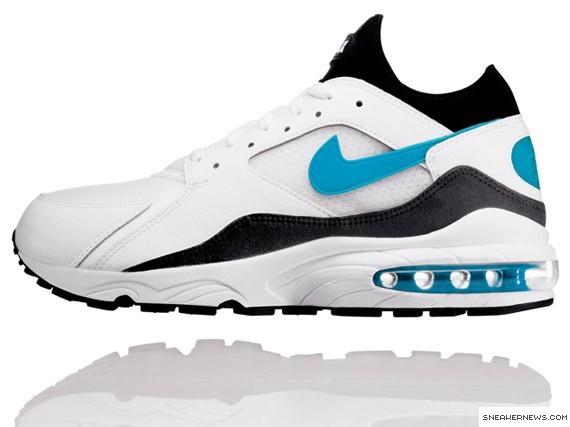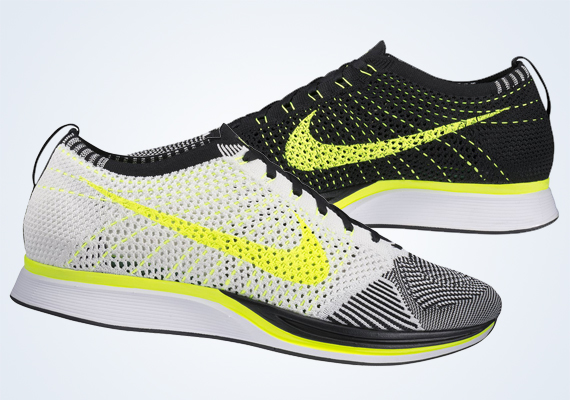 |
| Above: Nike Shox Below: Nike Airs |
 When I think of the
dynasty that is Nike shoes, the first things that come to mind are the Nike
Airs and the Nike Shox. Both were pivotal designs as Nike looked to break
barriers that had never been reached by competing companies. The classic design
of the Air Max set the standard for all trainer type shoes. Its cushioning technology
advanced the common tennis shoe of just being a fashion statement, to becoming
something that could help enhance an athlete’s performance. Then the
introduction of the Shox at the turn of the century took the sports world by
storm. Something so ingenious and outside the box had never been done before;
springs on the bottom of a shoe? Not only did the Shox provide an eye-catching
design, but it aided the athlete in cushioning their step which lead to injury
prevention. Since 2000 the world has been waiting for the next big thing to
appear from Nike. In 12 short years, the future of the tennis shoe was
announced. The Nike Flyknit.
When I think of the
dynasty that is Nike shoes, the first things that come to mind are the Nike
Airs and the Nike Shox. Both were pivotal designs as Nike looked to break
barriers that had never been reached by competing companies. The classic design
of the Air Max set the standard for all trainer type shoes. Its cushioning technology
advanced the common tennis shoe of just being a fashion statement, to becoming
something that could help enhance an athlete’s performance. Then the
introduction of the Shox at the turn of the century took the sports world by
storm. Something so ingenious and outside the box had never been done before;
springs on the bottom of a shoe? Not only did the Shox provide an eye-catching
design, but it aided the athlete in cushioning their step which lead to injury
prevention. Since 2000 the world has been waiting for the next big thing to
appear from Nike. In 12 short years, the future of the tennis shoe was
announced. The Nike Flyknit.
Lightweight. Intricate. Fast. The perfect shoe had been born
and it was only the beginning. It looked as if a colorful quilt had been sewn
onto a shoe. As the bombardment of different styles and colors under the
Flyknit technology began, I was entranced by this never seen before shoe
design. Gone were the generic mesh, plastic, and leather covered shoes. No, now
all I was intrigued by was the shoe that looked as if it had been knitted by my
grandma. There was the Flyknit Racer (my
favorite design), then the Nike Trainer, and followed by Nike Hyperfeel, a shoe
that looked and fit as if a sock. Runners throughout the world rejoiced as the
lightest shoes in recent history hit the market. But, it didn’t stop there.
Then came the release of the Flyknit technology in other sports. When Kobe
Bryant released his Kobe 9 Elite Basketball shoes I was in awe of a shoe that
looked as if he had taken a running shoe and molded it into the shape of a
basketball shoe. Gone were the generic basketball shoes with the simple Nike
swoosh adorning the sides. The Kobe 9’s were sleek, creative, and looked as if
they had come from another planet. These shoes blew me away and I would have
bought them if I was the flashy, confident basketball player that those shoes
exemplified. The Nike Flyknit technology follows in the footsteps of the great
shoes of the past. It has great design appeal and focuses on the athletes’
performance.
So the question now is, what’s next for Nike’s Flyknit shoe?
How can they once again top such a great design? I think that if Nike really
wants to go big, they need to integrate Flyknit design into everything they do.
Another way Nike can look to take their shoes to the next level would be by
continuing to pair the Flyknit design with their Lunarlon cushioning
technology, which helps create a lightweight shoe with great foot support. Not
only does this addition enhance the effectiveness of both shoe technologies,
but I think that it gives the shoe a great look that would be hard to compete
with. Personally, I feel like this is only the beginning of a long line of
great things to be seen from Nike with their Flyknit technology. I am already
anticipating the release of Nike’s 2015 Flyknit designs as they look to break
barriers in design, comfort, and performance. I am hoping for shoes with the
combination of the Flyknit and Lunarlon, or maybe and entirely new technology
that will be greater than the Flyknit I have come to love. So the answer is
yes, Nike’s Flyknit design reigns supreme in the shoe world of today. Its
design alone sets this shoe style apart from any other seen in recent history.
Images and Information courtesy of www.sneakernews.com

No comments:
Post a Comment